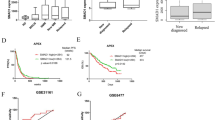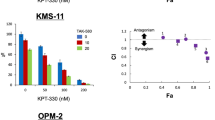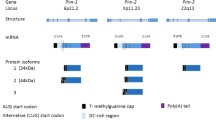Abstract
Multiple myeloma (MM) remains incurable by conventional chemotherapy. Sphingosine-1-phosphate (S1P) receptor-mediated signaling has been recently demonstrated to have critical roles in cell survival and drug resistance in a number of hematological malignancies. To dissect the roles of S1P receptor pathway in MM, we systematically examined cell viability and protein expression associated with cell survival and drug resistance in MM cell lines upon treatment with either pathway activator (S1P) or inhibitor (FTY720). Our results reveal that FTY720 inhibits cell proliferation by downregulating expression of target genes, while S1P has an opposite effect. Knocking down of S1P receptor S1P5R results in a reduction of cell survival-related gene expression; however, it does not have impacts on expression of drug resistance genes. These results suggest that S1P signaling plays a role in cell proliferation and drug resistance in MM, and targeting this pathway will provide a new therapeutic direction for MM management.






Similar content being viewed by others
References
Grammatikos G, Schoell N, Ferreirós N et al (2016) Serum sphingolipidomic analyses reveal an upregulation of C16-ceramide and sphingosine-1-phosphate in hepatocellular carcinoma. Oncotarget 7:18095–18105
Lee J, Yeganeh B, Ermini L et al (2015) Sphingolipids as cell fate regulators in lung development and disease. Apoptosis 20:740–757
Maceyka M, Spiegel S (2014) Sphingolipid metabolites in inflammatory disease. Nature 510:58–67
Morad SA, Cabot MC (2013) Ceramide-orchestrated signalling in cancer cells. Nat Rev Cancer 13:51–65
Proia RL, Hla T (2015) Emerging biology of sphingosine-1-phosphate: its role in pathogenesis and therapy. J Clin Invest 125:1379–1387
White C, Alshaker H, Cooper C et al (2016) The emerging role of FTY720 (fingolimod) in cancer treatment. Oncotarget 17:23106–23127
Siehler S, Manning DR (2002) Pathways of transduction engaged by sphingosine-1-phosphate through G protein-coupled receptors. Biochim Biophys Acta 1582:94–99
Radeff-Huang J, Seasholtz TM, Matteo RG et al (2004) G protein mediated signaling pathways in lysophospholipid induced cell proliferation and survival. J Cell Biochem 92:949–966
Taha TA, Argraves KM, Obeid LM (2004) Sphingosine-1-phosphate receptors: receptor specificity versus functional redundancy. Biochim Biophys Acta 1682:48–55
Devine KM, Smicun Y, Hope JM et al (2008) S1P induced changes in epithelial ovarian cancer proteolysis, invasion, and attachment are mediated by Gi and Rac. Gynecol Oncol 110:237–245
Lee MJ, Evans M, Hla T (1996) The inducible G protein-coupled receptor edg-1 signals via the G(i)/mitogen-activated protein kinase pathway. J Biol Chem 271:11272–11279
Windh RT, Lee MJ, Hla T et al (1999) Differential coupling of the sphingosine 1-phosphate receptors Edg-1, Edg-3, and H218/Edg-5 to the G(i), G(q), and G(12) families of heterotrimeric G proteins. J Biol Chem 274:27351–27358
An S, Bleu T, Zheng Y (1999) Transduction of intracellular calcium signals through G protein-mediated activation of phospholipase C by recombinant sphingosine 1-phosphate receptors. Mol Pharmacol 55:787–794
Ancellin N, Hla T (1999) Differential pharmacological properties and signal transduction of the sphingosine 1-phosphate receptors EDG-1, EDG-3, and EDG-5. J Biol Chem 274:18997–19002
Van Brocklyn JR, Gräler MH, Bernhardt G et al (2000) Sphingosine-1-phosphate is a ligand for the G protein-coupled receptor EDG-6. Blood 95:2624–2629
Malek RL, Toman RE, Edsall LC et al (2001) Nrg-1 belongs to the endothelial differentiation gene family of G protein-coupled sphingosine-1-phosphate receptors. J Biol Chem 276:5692–5699
Im DS, Heise CE, Ancellin N et al (2000) Characterization of a novel sphingosine 1-phosphate receptor, Edg-8. J Biol Chem 275:14281–14286
Graler MH, Goetzl EJ (2004) The immunosuppressant FTY720 down-regulates sphingosine 1-phosphate G-protein-coupled receptors. FASEB J 18:551–553
Oo ML, Thangada S, Wu MT et al (2007) Immunosuppressive and anti-angiogenic sphingosine-1-phosphate receptor-1 agonists induce ubiquitinylation and proteasomal degradation of the receptor. J Biol Chem 282:9082–9089
Gao Y, Gao F, Chen K et al (2015) Sphingosine kinase 1 as an anticancer therapeutic target. Drug Des Devel Ther 9:3239–3245
Zhang L, Wang X, Bullock AJ et al (2015) Anti-S1P antibody as a novel therapeutic strategy for VEGFR TKI-resistant renal cancer. Clin Cancer Res 21:1925–1934
Matula K, Collie-Duguid E, Murray G et al (2015) Regulation of cellular sphingosine-1-phosphate by sphingosine kinase 1 and sphingosine-1-phosphate lyase determines chemotherapy resistance in gastroesophageal cancer. BMC Cancer 15:762
Brizuela L, Martin C, Jeannot P et al (2014) Osteoblast-derived sphingosine 1-phosphate to induce proliferation and confer resistance to therapeutics to bone metastasis-derived prostate cancer cells. Mol Oncol 8:1181–1195
Marvaso G, Barone A, Amodio N et al (2014) Sphingosine analog fingolimod (FTY720) increases radiation sensitivity of human breast cancer cells in vitro. Cancer Biol Ther 15:797–805
Rosa R, Marciano R, Malapelle U et al (2013) Sphingosine kinase 1 overexpression contributes to cetuximab resistance in human colorectal cancer models. Clin Cancer Res 19:138–147
Pohl A, Lage H, Muller P et al (2002) Transport of phosphatidylserine via MDR1 (multidrug resistance 1) P-glycoprotein in a human gastric carcinoma cell line. Biochem J 365:259–268
Schaich M, Soucek S, Thiede C et al (2005) MDR1 and MRP1 gene expression are independent predictors for treatment outcome in adult acute myeloid leukaemia. Br J Haematol 128:324–332
García-Bernal D, Redondo-Muñoz J, Dios-Esponera A et al (2013) Sphingosine-1-phosphate activates chemokine-promoted myeloma cell adhesion and migration involving α4β1 integrin function. J Pathol 229:36–48
Yabu T, Tomimoto H, Taguchi Y et al (2005) Thalidomide-induced antiangiogenic action is mediated by ceramide through depletion of VEGF receptors, and is antagonized by sphingosine-1-phosphate. Blood 106:125–134
Neviani P, Santhanam R, Oaks JJ et al (2007) FTY720, a new alternative for treating blast crisis chronic myelogenous leukemia and Philadelphia chromosome-positive acute lymphocytic leukemia. J Clin Invest 117:2408–2421
Liao A, Hu R, Zhao Q et al (2012) Autophagy induced by FTY720 promotes apoptosis in U266 cells. Eur J Pharm Sci 45:600–605
Pilorget A, Demeule M, Barakat S et al (2007) Modulation of P-glycoprotein function by sphingosine kinase-1 in brain endothelial cells. J Neurochem 100:1203–1210
Miller DS (2014) Sphingolipid signaling reduces basal P-glycoprotein activity in renal proximal tubule. J Pharmacol Exp Ther 348:459–464
Strader CR, Pearce CJ, Oberlies NH (2011) Fingolimod (FTY720): a recently approved multiple sclerosis drug based on a fungal secondary metabolite. J Nat Prod 74:900–907
Ward MD, Jones DE, Goldman MD (2014) Overview and safety of fingolimod hydrochloride use in patients with multiple sclerosis. Expert Opin Drug Saf 13:989–998
Liao A, Broeg K, Fox T et al (2011) Therapeutic efficacy of FTY720 in a rat model of NK-cell leukemia. Blood 118:2793–2800
Xing Y, Wang ZH, Ma DH et al (2014) FTY720 enhances chemosensitivity of colon cancer cells to doxorubicin and etoposide via the modulation of P-glycoprotein and multidrug resistance protein 1. J Dig Dis 15:246–259
Funding
This work was supported by the Natural Science Foundation of China (81272629).
Author information
Authors and Affiliations
Corresponding author
Additional information
Di Fu and Yingchun Li contributed equally to this work.
Rights and permissions
About this article
Cite this article
Fu, D., Li, Y., Li, J. et al. The effect of S1P receptor signaling pathway on the survival and drug resistance in multiple myeloma cells. Mol Cell Biochem 424, 185–193 (2017). https://doi.org/10.1007/s11010-016-2854-3
Received:
Accepted:
Published:
Issue Date:
DOI: https://doi.org/10.1007/s11010-016-2854-3




